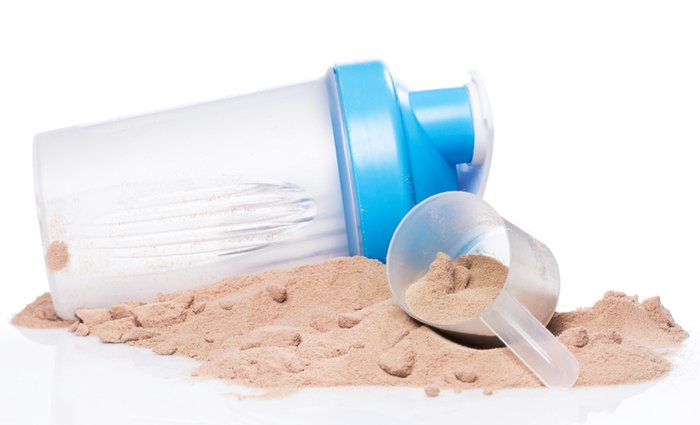Children of all ages require healthy eating to meet their daily needs for proper growth and development. Protein is of particular importance because of the wide variety of roles it plays in the body.
Protein is a critical component of several hormones and enzymes, and also plays an important role in recovery and repair of skeletal muscle following exercise.
Because of the popularity of protein powder for athletes, particularly among teenagers and young adults, it may be tempting to reach for that shake to make sure your children are getting everything they need. But should protein powder be included among the list of other healthy after-school snacks? Let’s take a closer look.
Why Do Kids Need Protein?
During childhood, protein becomes incredibly important to maintain normal functioning of the body and provide building blocks to support growth. Because growth is occurring at such a rapid rate throughout childhood, the amount of protein a child ingests is absolutely critical. In fact, low protein intakes have been shown to result in reduced stature compared to similarly-aged children.[1]

On the other hand, protein intakes that are consistently too high throughout childhood have been shown to be associated with increased risk for being overweight or obese in later stages of childhood and in early adulthood.[2] Prior research seems to indicate this risk is further increased with higher intake of animal proteins compared to plant-based proteins.[3,4]
However, it’s important to keep in mind that this is only when protein intake is exceptionally high, usually above 20 percent of total daily calories. Based on the literature, it seems that 12-15 percent of daily calorie intake for children should come from protein.
What Is the Best Protein for Kids?
When you are trying to decide what protein-rich foods are best for your children, remember that as long as your child has no dietary restrictions, animal-based sources such as meats and dairy are better than their plant-based counterparts for promoting growth and development, as well as recovery from exercise.
One of the reasons for this is because of the amino acid, leucine. Leucine is a major regulator of protein synthesis. While the majority of animal-based proteins contain more than enough leucine to promote protein synthesis, many plant-based sources do not. Additionally, research has shown that even when matched for leucine content, animal-based proteins such as milk or beef yield a superior protein synthesis response compared to plant protein.[5,6]
Therefore, it is better to use animal sources such as milk, cottage cheese, yogurt, lean meats, and eggs to provide the bulk of daily protein intake. Use healthy snacks such as nuts, peanut butter, and hummus to fill in other gaps in nutrition, but not as a primary source of protein. And although a milk or yogurt smoothie can be a healthy, protein-packed snack, a balanced diet rich in whole foods should provide enough nutrition for most kids.
How Much Protein Do Kids Need?
So how much protein does your kid actually need each day? The answer depends on a lot of factors, particularly age, body size, and activity level. Larger children are going to require more protein than smaller children, and an active kid will require more protein a sedentary kid.

However, adequate intake of macronutrients should always be based on total daily calories. Therefore, daily calorie intake is the best way to accurately determine protein needs.
According to updated dietary guidelines published by the U.K.-based Scientific Advisory Committee on Nutrition, who advise the U.K. government on diet and health, males and females between 4-6 years old should consume an average of approximately 1,500 and 1,400 calories per day, respectively.[7] However, between the ages of 16 and 18, this number creeps up to approximately 3,000 calories per day for males and 2,450 per day for females.
Based on these same nutritional guidelines, children between the ages of 4-6 should consume around 20 grams of quality protein per day, while teenagers should consume between 42 and 55 grams per day. This amount is easily obtainable through high-quality low-fat animal protein and common high-protein dairy sources such as milk, Greek yogurt, and cottage cheese.
This value increases for athletes due to the increased demand for amino acids to help the body recover from exercise. In spite of this, even teenage athletes shouldn’t need more than about 1.4 grams of protein per kilogram of body weight per day.[8]
Is Protein Powder Safe for Kids?
One of the most important factors in determining whether or not you want to give something to your children is whether or not that food or ingredient is safe for them to consume.
In the case of protein powders, the answer to that question is unequivocally, yes. However, just because something is safe doesn’t mean it should be a regular part of a child’s diet. If protein intake is too high, it can increase risk for obesity later in life.[4]
Because the protein requirements of children are already relatively low compared to adults, the extra protein found in meal replacement powders can easily put even teenagers over the ideal threshold. So, although a protein shake is safe for kids and a great source of protein when used as a meal replacement, regularly adding a protein-rich smoothie to your child’s daily diet is probably not necessary unless he or she does not get enough quality protein in their diet.
How Much Protein Does a Teenager Need to Build Muscle?
During the teenage years, it is not uncommon to experience an increase in physical activity due to increased participation in competitive sports and methods of physical activity such as resistance training.
While the increased activity and growth associated with puberty leads to increased demand for protein, that increased intake still falls within the recommendations of 12-15 percent of total daily calories. For most teenage athletes, this comes out to 65-80 grams per day.

Most commercially available protein powders provide 20-25 grams of protein per serving—about 25 percent of RDA by even the most generous protein estimations! Therefore, even in teenage athletes, it is likely a better option to reach into the pantry than the protein tub.
Should you give your kid a protein shake? The choice is completely up to you. Protein supplements are safe for consumption by individuals of all ages, but protein requirements of children are so relatively low that all children should easily be able to meet their protein needs with a normal, healthy, varied diet.
If you do decide to buy protein powder for your child or teenager, look for a high-quality whey, veggie, or protein isolate with less than 20 grams of protein per serving to be used after workouts only. So, if your kid is an athlete, it’s safe to swap the fruit roll-ups for protein bars and add a protein drink in every now and then, but it’s not absolutely necessary.
References
- Michaelsen, K. F., Larnkjær, A., & Mølgaard, C. (2012). Amount and quality of dietary proteins during the first two years of life in relation to NCD risk in adulthood. Nutrition, Metabolism and Cardiovascular Diseases, 22(10), 781-786.
- Wright, M., Sotres-Alvarez, D., Mendez, M. A., & Adair, L. (2017). The association of trajectories of protein intake and age-specific protein intakes from 2 to 22 years with BMI in early adulthood. British Journal of Nutrition, 117(5), 750-758.
- Halkjær, J., Olsen, A., Overvad, K., Jakobsen, M. U., Boeing, H., Buijsse, B., … & Wareham, N. J. (2011). Intake of total, animal and plant protein and subsequent changes in weight or waist circumference in European men and women: the Diogenes project. International Journal of Obesity, 35(8), 1104.
- Lind, M. V., Larnkjær, A., Mølgaard, C., & Michaelsen, K. F. (2017). Dietary protein intake and quality in early life: impact on growth and obesity. Current Opinion in Clinical Nutrition & Metabolic Care, 20(1), 71-76.
- Tang, J. E., Moore, D. R., Kujbida, G. W., Tarnopolsky, M. A., & Phillips, S. M. (2009). Ingestion of whey hydrolysate, casein, or soy protein isolate: effects on mixed muscle protein synthesis at rest and following resistance exercise in young men. Journal of Applied Physiology, 107(3), 987-992.
- van Vliet, S., Burd, N. A., & van Loon, L. J. (2015). The Skeletal Muscle Anabolic Response to Plant-versus Animal-Based Protein Consumption1. The Journal of Nutrition, 145(9), 1981-1991.
- Scientific Advisory Committee on Nutrition. (2012). Dietary reference values for energy. The Stationery Office.
- Boisseau, N., Vermorel, M., Rance, M., Duché, P., & Patureau-Mirand, P. (2007). Protein requirements in male adolescent soccer players. European Journal of Applied Physiology, 100(1), 27-33.
from Weight Loss Insider https://ift.tt/2AO4jYW
via Best Weight Loss Supplement
0 comments:
Post a Comment